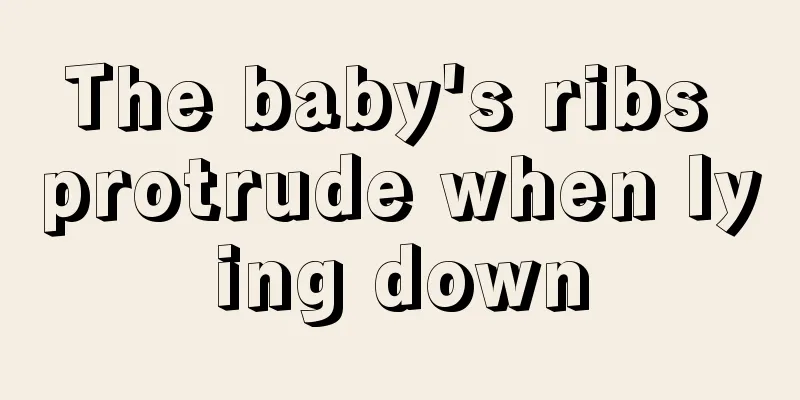The baby's ribs protrude when lying down

|
The baby's physical health is the most important, but some babies suffer from physical illnesses because they do not develop good living habits. What parents should pay attention to is that good habits should be cultivated from an early age, but if they often do not pay attention to some bad behaviors, it may easily lead to physical deformities in the baby. The baby is in a period of physical growth, and exercise or the cultivation of good habits is very important. Why does the baby's ribs protrude when lying down? Pectus pigeonae is a common disease in children, characterized by a protruding sternum and flat chest walls on both sides. In mild cases, the appearance is unsightly; in severe cases, the chest volume is reduced, lung development is restricted (the alveolar volume may increase in children before 8 years old), bronchitis or pneumonia may occur frequently, exercise tolerance is poor, and resistance is low. Causes In a small number of children, pigeon chest is congenital, but in most children, pigeon chest is caused by rickets. The skeleton of infants and young children is composed of cartilage. If the supply of vitamin D and calcium is neglected or insufficient at this time, calcium and phosphorus absorption will be impaired, resulting in osteomalacia. The connection between the chest ribs and sternum will sink inward, causing the sternum to bulge forward and form pigeon chest. This deformity often forms around 1 year old, but in fact, pigeon chest after 2 to 3 years old is the sequelae of rickets in children. In addition to pigeon chest, children often have other deformities, such as square head, "X" shaped legs, "O" shaped legs and so on. Treatment After chicken breast is formed, as children grow older and eat ordinary meals for nutrition, they get enough vitamin D, and calcium salts are deposited on the cartilage. The cartilage turns into bone, and the chicken breast is fixed as the basic framework of metabolism. At this time, chicken breast can no longer be cured by simple medicine and nutrition. Therefore, the prevention and treatment of pigeon chest in children must focus on preventing rickets. When treating pectus carinatum, attention should be paid to the age of the child and the condition of rickets. Rickets is often in the active stage before the age of 3 and enters the stable stage after the age of 3. The former is mainly used to treat rickets after pigeon chest occurs, while the latter is mainly used to correct deformities. For children with pigeon chest under 3 years old, anti-rickets treatment should be actively given, including diet therapy, vitamin D therapy, and calcium supplementation if necessary. Children over 3 years old mostly suffer from sequelae, and treatment with calcium and vitamin D is ineffective. Generally, mild pectus carinatum will gradually disappear as the body grows. Strengthening physical exercise, such as chest expansion exercises, push-ups, head-lifting exercises, etc., two to three times a day, can accelerate the correction of the deformity. |
<<: The baby's ribs are protruding on one side
>>: How to treat lumbar herniation in children
Recommend
What is the relevant knowledge about the order of children's tooth replacement?
We all know that in the process of children's...
What are the solutions for children with recurrent high fever caused by bacterial infection?
Bacteria exist everywhere in our lives, and there...
How to care for babies born by caesarean section
According to the latest data, the caesarean secti...
What are some ways for children to grow taller quickly?
I believe that everyone agrees with this truth in...
What are the sequelae of neonatal cerebral hemorrhage?
After a child is born prematurely, he or she is l...
What is the best way to treat baby's buttocks?
Many mothers think that when the baby goes to the...
Newborn baby not urinating
In fact, the urination and defecation conditions ...
How old should babies be to start adding complementary foods?
Nowadays, every family wants to have one child, s...
What are the symptoms of nasal hypertrophy in children?
Turbinate hypertrophy is a common chronic nasal d...
What are the treatments for bronchial asthma in children?
Bronchial asthma is a common airway disease. Acco...
What to do if your baby's eyelashes grow inward
The healthy growth of the baby is an issue that e...
5 ways to develop your child's financial intelligence
Method 1: Help children establish a correct view ...
How to treat vitiligo in children effectively
Children are the hope of the motherland and the f...
Is cupping good for children?
The reason why traditional Chinese medicine is hi...
Symptoms of diarrhea and dehydration in children
Children must pay attention to controlling their ...









